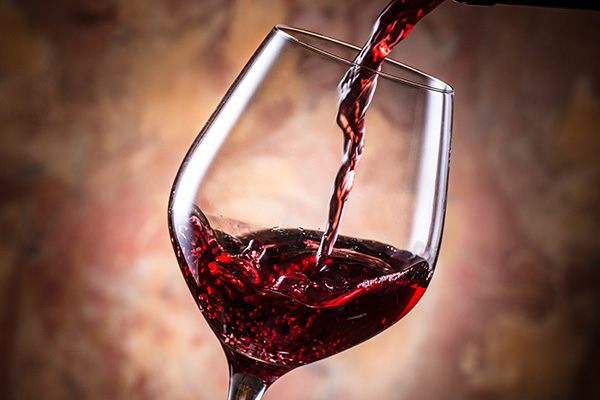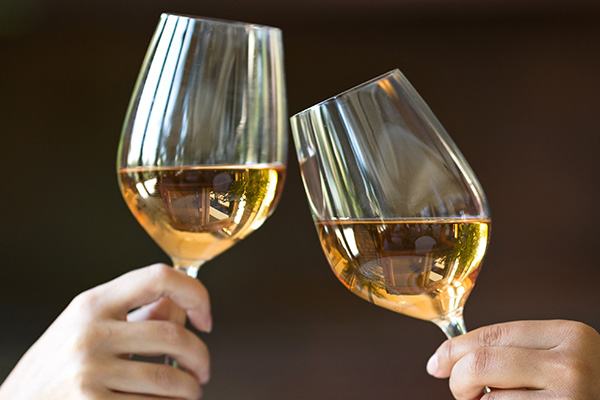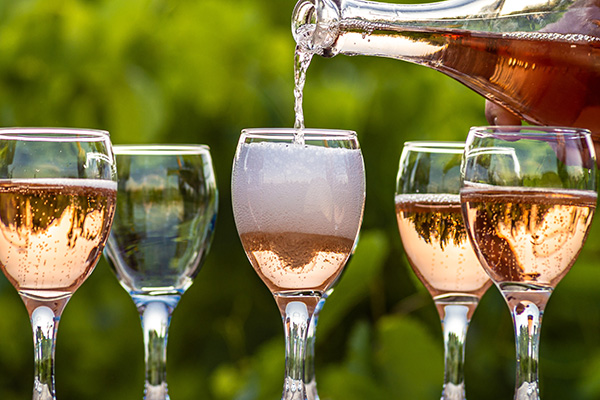
Royale Liquors is a full liquor department offering a wide selection of wine, beer, liquor, and champagne. You can visit Royale Liquors at select Pete’s Market locations.
You will find a stocked beer selection of old favorites as well as new craft beers from around the country. Our wine selection fits every budget from something simple on a Friday night to a bottle fit for a special occasion. We also carry the spirits and mixers you will need to create your favorite cocktail. If you are looking to try something new, watch our Facebook page for announcements about tastings at your local store.
Wine 101
Don’t be intimidated by wine! Enjoying wine is about finding what you like and what pleases your palate. It’s impossible to say there is a perfect way to swirl, sniff, and sip your wine. At Pete’s Market, we get that and want to help you find new bottles to select that next perfect sip. If you happen to be more of a novice in the world of wine, take the crash course below.
Words To Know
Dry – Don’t worry, if the wine is dry it didn’t evaporate! Dry is just the term used to describe the opposite of sweet. It often causes your mouth to pucker due to the lower amounts of sugar left in the wine.
Tannins – It’s a compound found in wine that gives it a bitter and dry pucker. When you think of the taste of red wine, you are thinking of the tannin.
Terroir – This is simply a fancy way to describe the flavors of the wine. Depending on where and when the grapes were harvested, each bottle will have a unique flavor that comes from the soil in which it was grown. This is what gives some white wines that mineral taste and some big reds the deep berry flavor.
Varietal – Each type of grape is its own varietal. For instance, Merlot is one of the most recognizable varietals. Some vineyards create blends that consist of multiple varietals. The varietals will often be listed as percentages on the label.
Technique
Storage – Wine is best kept in a cool, dark place ideally around 55°F to 65°F.
Opening – Letting wine breathe is the best way to enhance all its unique flavors. Simply take off the cork and pour into a decanter or straight to the glass. Then, let the wine rest for ten to twenty minutes for the aromas to open up.
Tasting – This is the old standby, but we won’t tell anyone if you just go for it. First, look at the color in your glass. Second, swirl the wine to give it one big breath. Third, smell the wine and try to pick out different notes. Fourth, take a sip and slowly swish it around your mouth. This is the best way to pick up all of the flavors. Fifth, enjoy the rest of the glass as you please!



Red
Cabernet Sauvignon [cab-er-NAY SO-vin-yon] – Definitely a big hitter, Cab (as it’s known for short) is filled with rich flavors like currant, plum, and black cherry. It’s perfect for hearty meals with red meat, lamb, pasta with marinara, or rich chocolate desserts.
Malbec [MAHL-beck] – This varietal has been an increasingly popular South American favorite. Incredibly affordable for its quality, you can find many different Malbec bottles in our stores. It’s the perfect bottle to pick up when you’re planning a beef or tomato-based dinner.
Merlot [mur-LO] – After having its heyday back in the 80’s, Merlot has made a comeback in recent years. Its style varies but often has notes of currant and cherries. Again, pair it with roasted red meats, duck, lamb, and robust cheeses.
Pinot Noir [PEE-no NWA] – Pinot Noir is the darling of the Pacific Northwest. Known for being at its best when grown in the Willamette Valley of Oregon, this varietal has a complex blend of black cherries, spices, raspberries, and roses. With a bold blend of earthy flavors, pair this wine with turkey, beef, lamb, pork, and game birds.
Sangiovese [san-geeo-VEHS-eh] – This spicy grape has notes of raspberry and the spice anise. Pair it with beef, veal, pork, pasta with marinara, poultry, and rich cheeses.
Shiraz [shih-RAHZ] – You may also see it on shelves under the name syrah [sir-RAH]; this wine is complex and rich with spices, pepper, and even leather. It pairs well with beef, game birds, chicken, and turkey.
Tempranillo [temp-rah-NEE-yo] – This full-bodied Spanish wine has notes of cherry, oak, leather, and spice. It’s great to pair with a hearty meal of lamb, duck, beef, or tomato based dishes. It can also hold up to strong cheeses.
Zinfandel – [ZHIN-fan-dell] You are in for one powerful sip with a Zin. Heavy tannins and rich cherry pair well with anything from pizza to ribs.
White
Chardonnay [shar-dun-NAY] – Chardonnay was the counterpart to Merlot back in the 1980’s. This buttery wine is ripe and rich. You will notice undertones of apple, fig, lemon, and honey. Its richness is best paired with cream sauces, shellfish, poultry, pork, salmon, and rich cheeses.
Gewürztraminer [geh-VOORTZ-trah-MEE-ner] – It might be difficult to pronounce, but you’ll be glad you tried when you notice its spiced peach and apricot flavors. It’s another great pairing for spicy Asian dishes, pork, poultry, and mild cheese.
Pinot Grigio [PEE-no GREE-zho] – Made famous by reality television, Pinot Grigio or Pinot Gris [PEE-no GREE], is full of citrus, spices, and almonds. Let this wine flow in the summer months with rich pasta dishes or grilled chicken.
Riesling [REES-ling] – Hailing from Germany and the surrounding mountains, Riesling can take you from dry to sweet. Try all the different varieties to find the one that suits your taste. Its green apple flavor goes well with Asian food, grilled seafood, salmon, as well as a light snack of fresh fruit and mild cheese.
Sauvignon Blanc [SO-vin-yon BLAHNK] – Similar to Pinot Grigio, Sauvignon Blanc is perfect on a summer night out on the deck. The tropical fruit flavors complement soft cheese and seafood.
Sparkling
Bubbly isn’t just for special occasions anymore. We recommend enjoying sparkling wine at any time. Wondering why we aren’t just calling it Champagne? The Champagne region of France is actually the only place allowed to call their sparkling wine “Champagne”. Other regions around Europe have special names for it as well. You can find Cava in Spain, Sekt in Germany, and Prosecco, Asti, and Spumante from Italy. Once you know the difference, you’ll notice the aliases are much more affordable for smaller occasions.
Most sparkling wines are made from Chardonnay (Blanc de Blanc) and Pinot Noir (Blanc de Noir). Confused on how a red wine turns into sparkling wine? The red grape skins are removed in the beginning of the wine making process.
When selecting a sparkling wine, it’s best to have an understanding of the following words you’ll find on the label:
Brut – This is the driest sparkling wine available. It literally goes with everything.
Extra Dry – While it might sound drier than Brut, its actually slightly sweeter. It will have small hints of fruit before a dry finish. It is also very versatile and drinks well on its own before or after a meal.
Sec – Rarely seen, Sec is just a step above Extra Dry.
Demi-Sec – Having dessert? This sweet end of the sparkling spectrum is great with fresh fruit. Avoid it during the entrée portion of your meal.



